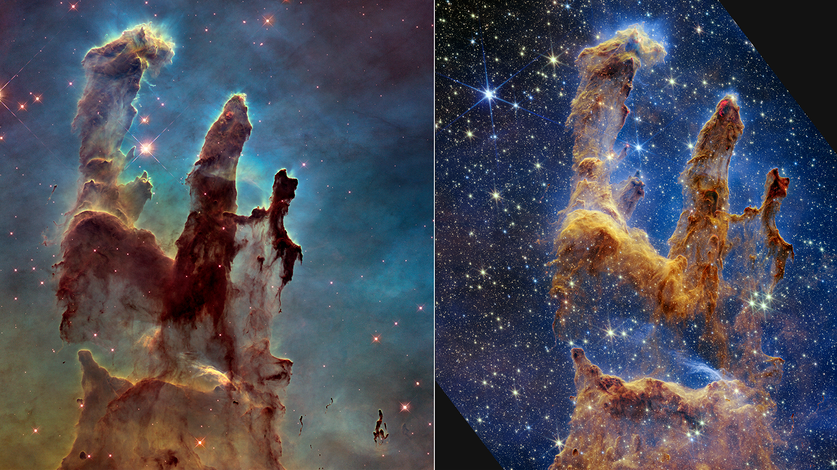
The Pillars of Creation taken by NASA's James Webb Space Telescope's near-infrared-light view. /NASA
The Pillars of Creation taken by NASA's James Webb Space Telescope's near-infrared-light view. /NASA
NASA's James Webb Space Telescope has captured the iconic Pillars of Creation, where new stars are forming within dense clouds of gas and dust, the agency said on Wednesday.
The three-dimensional pillars look like majestic rock formations, but are far more permeable. These columns are made up of cool interstellar gas and dust that appear semi-transparent in near-infrared light, according to NASA.
The wavy lines that look like lava at the edges of some pillars are ejections from stars which are still forming within the gas and dust. These stars are estimated to be a few hundred thousand years old, a quite young age for stars.

Photo comparison between an image (L) of the Pillars of Creation taken by NASA's Hubble Space Telescope in 2014 and a new view from NASA's James Webb Space Telescope released this October. /NASA
Photo comparison between an image (L) of the Pillars of Creation taken by NASA's Hubble Space Telescope in 2014 and a new view from NASA's James Webb Space Telescope released this October. /NASA
The view of the Pillars of Creation were first made famous when imaged by NASA's Hubble Space Telescope in 1995. It later revisited the scene in 2014 to reveal a sharper, wider view in visible light. Webb's new view of the Pillars of Creation will help researchers revamp their models of star formation by identifying far more precise counts of newly formed stars, along with the quantities of gas and dust in the region, said NASA. The scientists will increase their knowledge on how stars form and burst out of these dusty clouds over millions of years.
The James Webb Space Telescope is the world's premier space science observatory.
Webb will solve mysteries in the solar system, look beyond to distant worlds around other stars, and probe the mysterious structures and origins of our universe and our place in it, according to NASA.
Webb is an international program led by NASA with European Space Agency and Canadian Space Agency.
(With input from Xinhua)